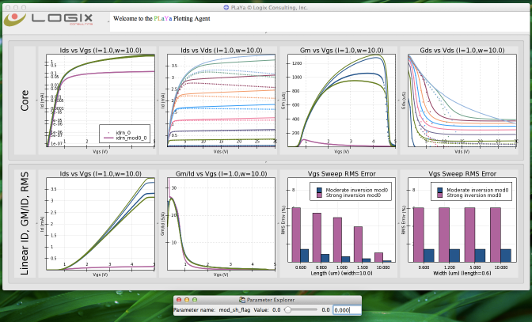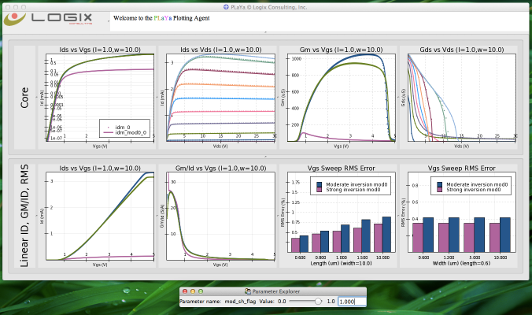Integrated high voltage power MOS transistors are key components in power management circuits IC's. Formed by adding a resistive drain extension region, these transistors can support much higher Vds operating voltages than conventional MOS transistors. But the drain extension can also complicate the physics of the transistor by introducing significant current-limiting and power dissipation effects. Accurate modeling of Power MOS transistors using conventional CMOS SPICE model equation sets requires a flexible subcircuit based modeling approach.
In the example below, a BSIM-based subcircuit was developed to fit the current-limiting compression effects in the Id-Vds characteritics. The data are represented by the dots and the SPICE model simulated values are represented by the solid lines. The RMS error between the simuated results and the data are plotted in the bar graphs for several different device sizes.

Figure 1: SPICE model (line) vs. data (points) for a Power MOS BSIM-based subcircuit model. The self-heating behavior evident in the negative output conductance cannot be modeled with the popular bulk-based BSIM MOS compact models.
However, the fit is compromised because the impact of self heating caused by power dissipation within the transistor (evident in the negative output conductance behavior) has been not been comprehended in the SPICE model. This lack of self heating is a limitation of existing MOS model equation sets like BSIM3 and BSIM4.
The result of enhancing the model subcircuit to include bias and time dependent self heating effects is shown below. In this implementation, the self heating effect has been implemented with a parameter switch shown at the bottom of the picture.

Figure 2: SPICE model (line) vs. data (points) for an enhanced Power MOS BSIM-based subcircuit model which includes self heating effects.
This subciruit can be further extended to capture impact ionization and buried body effects common in integrated high voltage Power MOS. Our flexible internal model development platform allows full optimization of all SPICE model and subcircuit parameter values and enables Logix to deliver accurate models even in the face of unconventional device behavior.
